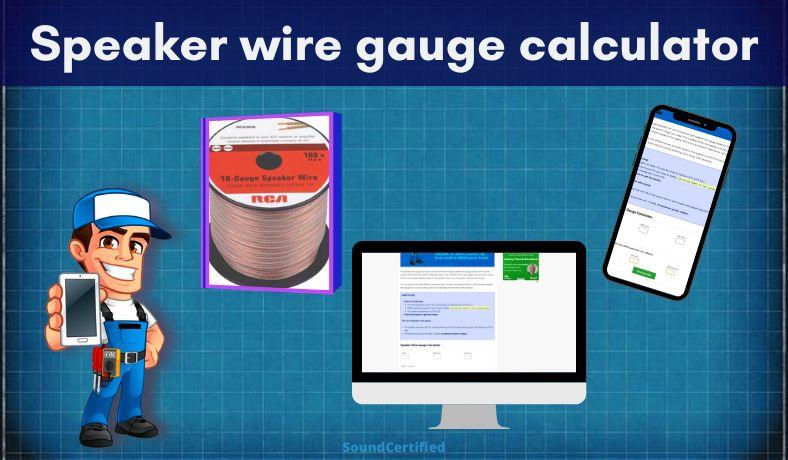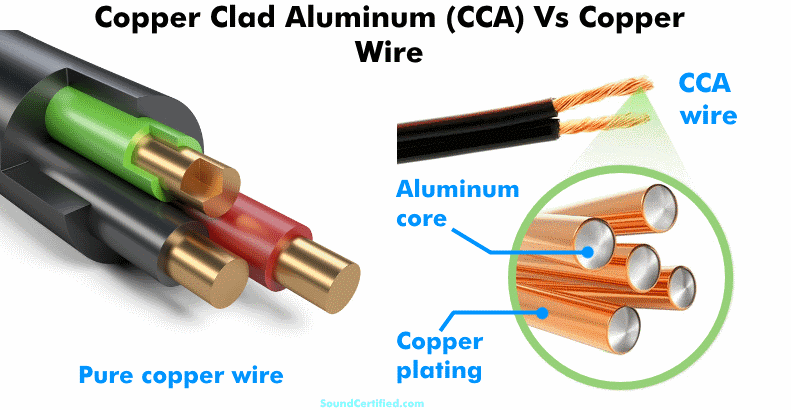Looking for the best way to find the right speaker wire gauge? You’re in the right place!
My custom speaker wire gauge calculator will make finding the right wire size a snap.
Note: Javascript must be enabled in your browser to see or use the tool.
Contents
SPEAKER WIRE GAUGE CALCULATOR
This custom-designed speaker wire gauge calculator will calculate electrical current carried based your specific inputs:
- Amplifier or stereo power per speaker channel
- Speaker Ohms
- Any length of wire you need
Using this, it will find the smallest speaker wire gauge that will work for your specific needs. My goal in designing this wire size calculator was to help you spend less money, avoid buying more wire than is needed, and keep wire use/installation hassle to a minimum.
Sometimes you can save money by buying shorter lengths of wire or using a smaller gauge than you thought you could otherwise. Feel free to play around with different lengths, exact speaker Ohm values, and power ratings to see what will work best for your speaker system.
HOW TO USE THE CALCULATOR:
- Input your values:
- Wire length. This can be whole or fractions (5 ft, 2.6 ft, etc.).
- RMS/continuous power for your amp or stereo. (Do not use “peak” or “max.” power ratings – this will throw your results WAY off.)
- The speaker impedance in Ohms (Ω).
- Touch the button to display your wire size data.
The wire calculator will output:
- The smallest acceptable wire size with 5% or less power loss for both copper and copper-clad aluminum (CCA) wire.
- The total power loss across the wire, in Watts, at maximum power output.
How the calculator is different from a wire size chart
- A wire size chart typically is based on only a few factors like length or speaker Ohms and isn’t tailored to your exact needs.
- A speaker wire gauge chart is helpful if you only have basic specs to go by or need something simple to use as a guideline.
The benefit of my calculator is that it can take into account nearly any power amount or speaker wire length. My goal as I mentioned was to make it possible to figure out the best size speaker wire based on all the specs that matter and help you find the smallest (least expensive) wire size that is best for you.
Money-saving speaker wire tips
As genuine copper wire is more expensive these days and since most people don’t drive speakers at full power, here are some ways to make the best of that and save money on wire:
- If you (like most people) rarely use your amp or stereo output above 50%-60% power, you can go down one wire AWG gauge. That’s because you’ll never reach the wire’s current capacity if you don’t use maximum power – there’s no need for a larger wire most of the time in that case.
- Have surplus wire lying around unused? You can double-up or even triple-up smaller gauge wire to get the same gauge as a thicker wire size. For example, using two lengths of 18AWG in parallel will be roughly the same as a 16AWG wire.
- For surround sound and center channel home theater speakers, you don’t need a large gauge or special wire. Their power needs are usually very low and don’t require as much power.
Is oxygen free speaker wire worth it?
No, oxygen-free pure copper wire will not deliver any improvements in sound or power you can even notice. It’s simply not worth the extra money.
It’s a great marketing feature for retailers but the data shows that there’s an amazingly small difference in performance. Paying more is a waste of money. As long as you’re using a good quality wire with the correct gauge you’ll be fine.
In fact, you’d need very sophisticated lab equipment to even prove any difference at all!
Heads up! Copper vs copper clad aluminum (CCA) speaker wire differences
Because of what I’ve seen in stores and how they’re different, I felt it was important to talk about copper vs copper-clad aluminum (CCA) wire. Over the last few years, the price of copper has gone up, resulting in some common things like speaker wire being substituted with non-pure copper wire without telling you!
This means if you’re not aware you could be using wire that’s not sufficient – or even get ripped off!
Why CCA wire falls short compared to copper
Unlike pure copper wire, copper-clad aluminum is based on an aluminum wire core with a thin copper plating. Sure – from the outside you’ll see the copper finish and it looks the same…but is it really?
The problem is that aluminum wire has only 61% (39% more resistance to the flow of electrical current) of the conductivity of copper wire. You won’t get the same performance at the same wire gauge.
This means it will take a larger CCA wire size to get the same power handling, capacity, and resistance of real copper wiring.
Does it matter for everyday use?
For everyday, average listening and low or moderate power levels, it’s not really a problem and you’ll be fine. However, if you’re going to drive speakers with high power levels, in a high-quality stereo system or speaker system, or want the wire capacity you should get, you’ll probably want to look for 100% copper wire.
Alternatively, you can use CCA wire and still get the same performance. To do so, you’ll need to move up at least one speaker wire gauge when buying CCA speaker wire.
For example, to replace 18 gauge copper wire, use a 16AWG or 14AWG CCA wire.


